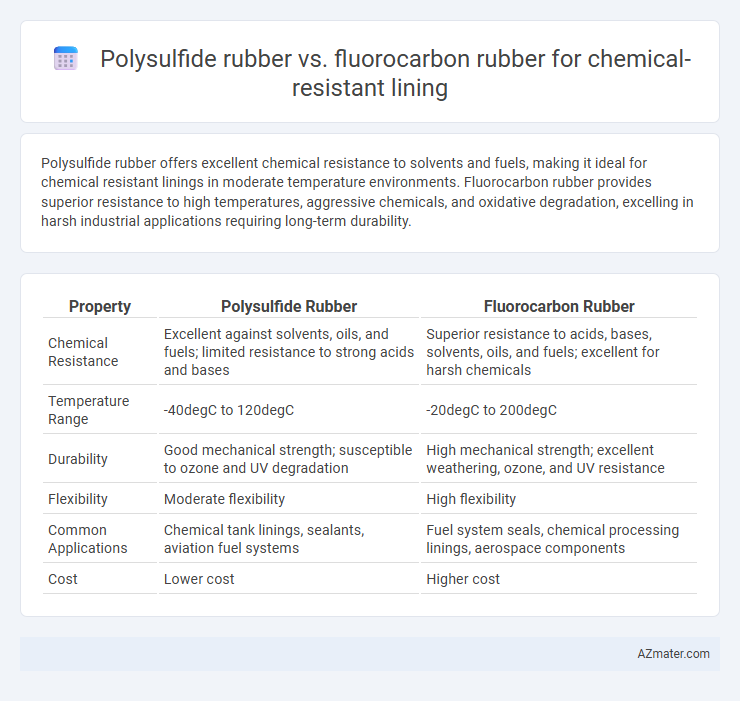Polysulfide rubber offers excellent chemical resistance to solvents and fuels, making it ideal for chemical resistant linings in moderate temperature environments. Fluorocarbon rubber provides superior resistance to high temperatures, aggressive chemicals, and oxidative degradation, excelling in harsh industrial applications requiring long-term durability.
Table of Comparison
| Property | Polysulfide Rubber | Fluorocarbon Rubber |
|---|---|---|
| Chemical Resistance | Excellent against solvents, oils, and fuels; limited resistance to strong acids and bases | Superior resistance to acids, bases, solvents, oils, and fuels; excellent for harsh chemicals |
| Temperature Range | -40degC to 120degC | -20degC to 200degC |
| Durability | Good mechanical strength; susceptible to ozone and UV degradation | High mechanical strength; excellent weathering, ozone, and UV resistance |
| Flexibility | Moderate flexibility | High flexibility |
| Common Applications | Chemical tank linings, sealants, aviation fuel systems | Fuel system seals, chemical processing linings, aerospace components |
| Cost | Lower cost | Higher cost |
Introduction to Chemical Resistant Linings
Chemical resistant linings are critical for protecting industrial equipment from aggressive chemicals, ensuring durability and safety in harsh environments. Polysulfide rubber offers excellent resistance to acids, alkalis, and solvents, making it suitable for moderate chemical exposure and flexible applications. Fluorocarbon rubber provides superior resistance to high temperatures and a broader spectrum of aggressive chemicals, including hydrocarbons and strong oxidizers, ideal for highly demanding chemical processing conditions.
Key Properties of Polysulfide Rubber
Polysulfide rubber offers excellent chemical resistance, particularly against fuel, solvents, and oil-based substances, making it highly suitable for protective linings in harsh industrial environments. Its key properties include outstanding flexibility, low permeability to gases and liquids, superior water resistance, and strong adhesion to metal substrates. The high durability and resistance to swelling and degradation in aggressive chemicals ensure long-lasting performance compared to fluorocarbon rubber.
Key Properties of Fluorocarbon Rubber
Fluorocarbon rubber (FKM) excels in chemical resistant lining due to its outstanding resistance to a wide range of chemicals, including oils, fuels, acids, and alkalis, maintaining integrity at temperatures up to 200-250degC. Its low permeability and excellent weathering resistance provide superior durability against ozone, UV radiation, and aging, outperforming polysulfide rubber in harsh conditions. Additionally, fluorocarbon rubber offers excellent mechanical strength and elastomeric properties, making it ideal for long-term industrial applications requiring robust chemical and thermal resistance.
Chemical Resistance Comparison
Polysulfide rubber exhibits excellent resistance to water, dilute acids, and alkalis but has limited resistance to strong oxidizing agents and aromatic hydrocarbons. Fluorocarbon rubber offers superior chemical resistance against a broad range of aggressive chemicals, including oils, fuels, solvents, and high-temperature acids, making it ideal for harsh chemical environments. Fluorocarbon's enhanced resistance to oxidative and thermal degradation surpasses polysulfide rubber, ensuring longer service life in demanding chemical lining applications.
Temperature and Environmental Stability
Polysulfide rubber exhibits excellent chemical resistance with a temperature tolerance typically up to 130degC, making it suitable for moderate thermal environments. Fluorocarbon rubber offers superior environmental stability and can withstand higher temperatures, generally up to 230degC, while resisting aggressive chemicals and UV degradation. For applications requiring prolonged exposure to extreme temperatures and harsh chemicals, fluorocarbon rubber provides enhanced durability and long-term performance compared to polysulfide rubber.
Mechanical Strength and Flexibility
Polysulfide rubber offers excellent chemical resistance with moderate mechanical strength and notable flexibility, making it ideal for lining applications requiring durability under dynamic stress. Fluorocarbon rubber, while superior in chemical resistance and thermal stability, typically exhibits higher mechanical strength but reduced flexibility compared to polysulfide, limiting its use in applications demanding extensive elongation or movement. Combining these properties, polysulfide rubber suits flexible chemical linings, whereas fluorocarbon rubber excels in high-strength, chemically aggressive environments.
Application Areas for Polysulfide Rubber
Polysulfide rubber is widely used in chemical resistant lining for applications such as fuel tanks, marine environments, and industrial storage containers due to its excellent resistance to hydrocarbons, solvents, and mild acids. It's particularly effective in sealing applications and protective coatings where flexibility and durability against chemical degradation are critical. Fluorocarbon rubber, while offering superior resistance to high temperatures and aggressive chemicals, is less commonly applied in large-scale lining projects requiring elasticity and long-term water resistance.
Application Areas for Fluorocarbon Rubber
Fluorocarbon rubber excels in chemical resistant lining applications requiring superior resistance to acids, solvents, fuels, and high temperatures, making it ideal for use in the aerospace, automotive, and chemical processing industries. Its outstanding performance in environments with aggressive chemicals and elevated thermal conditions ensures durability and reliability in sealing components, gaskets, and hoses. Compared to polysulfide rubber, fluorocarbon rubber is preferred in applications needing resistance to oils and hydrocarbons, especially in fuel systems and industrial machinery.
Cost and Maintenance Considerations
Polysulfide rubber offers a lower initial cost and simpler maintenance compared to fluorocarbon rubber, making it economically favorable for budget-sensitive chemical resistant lining projects. Fluorocarbon rubber, while more expensive upfront, provides superior chemical resistance and longer service life, reducing overall maintenance frequency and associated downtime costs. Choosing between the two depends on balancing upfront investment against long-term durability and maintenance requirements in harsh chemical environments.
Choosing the Right Rubber for Chemical Lining
Polysulfide rubber excels in chemical resistant lining due to its superior resistance to water, fuels, and solvents, making it ideal for applications involving aqueous and hydrocarbon chemicals. Fluorocarbon rubber offers exceptional stability against a broad range of aggressive chemicals, high temperatures, and oxidation, making it suitable for environments exposed to strong acids, alkalis, and high heat. Selecting the right rubber depends on the specific chemical exposure, temperature range, and mechanical durability requirements of the lining application.

Infographic: Polysulfide rubber vs Fluorocarbon rubber for Chemical resistant lining
 azmater.com
azmater.com